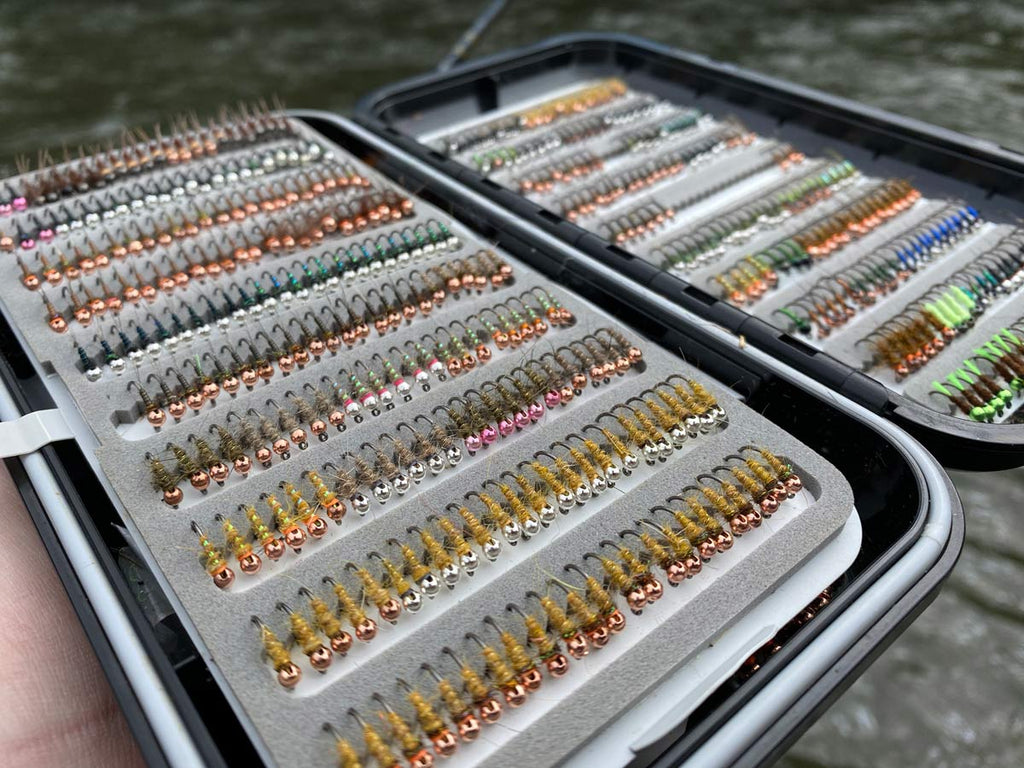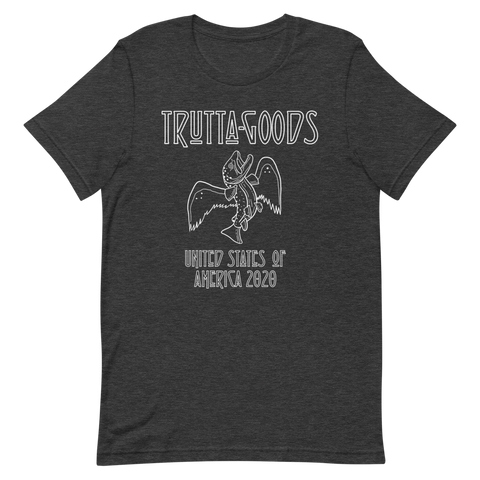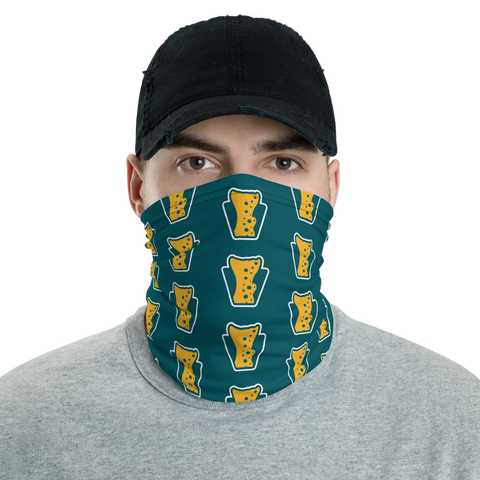
Light Euro-Nymphing - Part 6: The Flies
Euro-Nymphing: Fish lighter to improve your nymph game
Part 6: The Flies
This is a series of articles to help you fish lighter for improved euro-nymphing success.
Oh boy, the flies. We'll mostly talk about weights, sizes, profiles, and how/why to fish the flies. Patterns will be mixed in.
Putting all the info in previous parts of this series together, the rod, the leader, the tippet, and the cast, we can employ a lighter fly game that'll be more adaptive and get you better drifts.
Okay, so how do you become effective at fishing light flies? Really, after evaluating the tactics in the entire series, you just need to jump in wader boots first. It's probably going to be super weird and feel like you're swinging a light baseball bat after taking off the warm-up donut, or picking up an empty box that you thought was full. But what it really is going to be is "I can't feel my flies" - I've heard this from many folks, and this was the first thing I said when I started fishing this way. But, this is totally FINE! You may not feel them because, your mind and body is used to fishing a different way, or because one of the other parts (rod, leader, tippet) hasn't been incorporated or gained comfort on yet. I will say this though, that first hurdle is the hardest to get over, but once you're over it, it's smooth sailing.
Okay, but how do I really start? This is tricky to write in a blog post, because we're both not standing on a stream right now (and if you are, don't drop your phone).
Start light. Sometimes if I know that I'm going to have to start heavy, it's very hard for me to scale down because of the extra feel I get from having a heavier fly... and this is a problem. So, when I can, I start light. As light as you possibly can, because you'll find out very quickly if you're too light.
While I'm on a stream, I will start with one of the following combos:
- 2.5mm & 2.5mm (very common for moderate flow days on every stream I fish in PA)
- 2.0mm & 2.0mm (smaller streams, low flows)
- 2.5mm & 2.0mm (also very common for moderate flows)
- Single 2.5mm (pocket water or tight drift scenarios, which are mainly small current seams or slow shallow runs)
- Single 3.0mm (heavy pocket water)
With that said, it's pretty easy to tell if you're too light. A few signs:
- Your drift is moving visibly faster than the current on the surface. This is the easiest way to tell.
- Your flies are moving and/or swinging out of the current you entered into.
- Your flies aren't where you expect them to be when you pick them up out of the water (this could mean you're in a weird eddy or something, but sometimes it means you're too light)
If you come to this juncture, the easiest thing is to bump up by .5mm on one of your flies. Then work your way up if this continues to happen. I will caution, don't always rely on one drift to test this theory, as sometimes we make a bad cast, wind catches, or some other influence. Try a few times, then evaluate.
I will also add in the wind variable. Wind is the least fun part about nymphing. If is too difficult to control your drift or your cast, bump up your weight by .5mm and keep going up if this continues to happen. The extra weight will help ground your flies a little better so the wind doesn't effect your drift as much.
Once you find this, and make it over the first hurdle of the weird feel, you'll probably start picking up fish more frequently. That is the formula. Simple, but different for every angler, and every situation. You'll start to begin knowing what you need to fish with in each given run before you cast.
Okay, I wasn't going to make you read all that without talking about some flies.
We know that year-round, fish eat nymphs and other aquatic critters ranging in size from 16-20 more frequently than others, so I fish most of my patterns in #16-18.
As for weights (tungsten), about 40% of my active nymph box is 2.5mm, 25% 2.0mm, 25% 3.0mm, and 10% 3.5-4.0mm.
Now, being that weight on the flies is "light," that doesn't mean they sink slowly. The flies I fish have been designed to sink quickly, without a lot of bulk. The biggest thing to keep in mind is keeping your flies as thin as possible. This is achieved with thin thread and sparse material.
My top patterns:
The France Fly.

If I were asked to choose one pattern to fish with forever, it'd be the France Fly. Here's why:
- Durability - the micro-tubing creates a very strong "armor-like" shell, with some neat segmentation, all while not using any UV resin.
- Efficiency - they're super easy to tie, and without any UV resin, you can really churn them out.
- Sink-rate - so long as your dubbing collar is thin and sparse, these sink very quickly.
- The drift - My theory is, the contrast in materials hard body vs. sparse dubbing, they drift more naturally than other similar patterns.
- They just look like little nymphs.
You can create a ton of combinations for this fly. Hot spots, thread color, tube color, and dubbing color can change this up a lot. Here's the materials:
- #14-18 Trutta Goods Upside Downie
- 2.0mm-3.0mm Slotted Tungsten Bead (I like copper & silver)
- UTC 70 Thread
- Brown, olive-brown, olive, black, orange, grey
- I wouldn't suggest going heavier, as the fly will get thick.
- Hareline Micro Tubing
- Brown, olive-brown, olive, black
- CDL Tail
- 5-6 fibers.
- Fine Ice, UV Ice or Hare's ear dubbing
- The smallest pinch of dubbing, you don't want a large collar
The Walt's Worm.

This pattern is probably the most diverse, yet simple flies you can tie. The above pattern is a two-tone variation I like to fish during the spring and summer months. The important thing is to keep these thin, using the least amount of dubbing as possible.
- Efficiency - they're super easy to tie. You can use at little as one type of material.
- Sink-rate - so long as your dubbing is thin and sparse, these also sink very quickly.
- They represent any subaquatic insect at pretty much any time in the season.
- Versatility - tie "sexy" with flash or hot spots, CDC soft hackle, regular soft-hackle, tails, colored tag tails, and many other variations.
Materials for a basic Walt's worm:
- #14-18 Trutta Goods Upside Downie
- 2.0mm-3.0mm Slotted Tungsten Bead (I like copper & silver, sometimes pink)
- UTC 70 Thread (or literally whatever)
- Rib optional
- I like small pearl flash tinsel, gold or copper xs wire, or 6x mono.
- Dubbing
- Hare's ear, squirrel dubbing, or even a fine flash dubbing works best for me. The smallest amount possible. Try not to use longer dubbing, as it is tough to dub into small noodles.
Perdigon flies

This pattern was made popular in the US (I think) by Devin Olsen. He's made a lot of effective patterns available for us anglers, but this is one of the coolest. Like the walt's worm, you can tie these in so many variations for any given scenario. The pattern shown above is my "Greasy Perdigon" which I like to use in cloudy, high water.
- Efficiency - they're pretty easy to tie, but take a little extra time with the UV component.
- Sink-rate - probably the fastest sinking pattern on the planet.
- Versatility - tie them however you like, just keep them thin!
Materials for a Perdigon:
- #14-18 Trutta Goods Upside Downie
- 2.0mm-3.0mm Slotted Tungsten Bead (I like copper & silver)
- UTC 70 Thread (or literally whatever)
- Body - thread or flash
- Rib optional
- Glo-brite thread or other thread (pliva perdigon style), or flash.
- If using flash, I prefer a small holographic tinsel.
- CDL Tail
- 5-6 fibers
- UV Resin
- I'm not a big UV resin guy, so I don't have much of a recommendation here. I use Tactical Fly Fisher resin.
My nymph box is full of those 3 flies, tied in many different variations, colors, weights and sizes. I also like to throw in some very drab Pheasant tails for picky trout. I like to pigeonhole my nymph selection so I gain confidence easier and learn how to fish each pattern properly, in any given situation.
I also tie my nymphs on #16-18 Trutta Goods Old Mans, and sometimes #14-16 Trutta Goods Altoona Curvies so I can achieve different profiles and sizes.
There are so many other successful patterns that harbor similar attributes as the aforementioned flies, but whatever you choose to tie and fish, tie your nymphs simply and sparsely, and try to understand how they're fished.
Paring down my nymph game and fishing lighter is one of the most successful things I've done as an angler. Take some ideas from this series and try to incorporate it into your routine, and it may lead to many more fish, and more success on the water.
Thank you for reading, please feel free to reach out to me at any time with questions, observations, your success, or anything else fishing related!
Keep a look out for more posts on the Trutta Feed.
Tight lines!
- Nick Meloy



RICK SNYDER
I am using either Maxima or OPST to my leader / tippet. My problem is when figure 8 hand twisting I am creating twist in the line. Or is it from repetitive casting. I have to stop to take the twisted coils out of the line. Is this common? What can I do to prevent the twists?
Stephen Ruiz
You’re blog series along with Devin Olsen’s and Lance Egan’s "Adaptive Fly Fishing vid (Vimeo) inspired me to try going “light”. My first experience went better than expected (40 fish to hand) as I landed a 20" rainbow – I’m seeing the “light”!
Thanks!
Tom M
Great series. Very useful ideas, which I’ll use in my nymphing . Is there any method to using the colors of the beads. How is your fly box organized so you know tha different weights .?
This series will be store in my phone for quick reference. Thanks